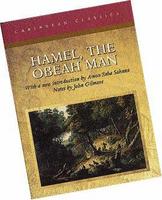
Title: Hamel, The Obeah Man
Author: Anonymous
Publisher: Macmillan Caribbean
Reviewer: Barbara Nelson
The notes by John Gilmore, the editor of the Caribbean Classics Series and the Introduction by Amon Saba Saakana, PhD, at the beginning of this anonymously written book greatly help to set the stage for readers of Hamel, The Obeah Man, written in 1827 and set in the island of Jamaica in the early 1820s.
In the first three pages of the introductory chapter Saakana says: "One is made aware of the inhabitants of two different worlds locked in the same geographical space."
melancholy looking white man
The story, in fact, starts with a melancholy looking white man on 'a sulky looking Spanish horse' riding along the western bank of the Rio Grande 'at the close of a sultry day'. He is accompanied by Cuffy, 'a bare-legged negro boy on foot, dressed in an Osnaburg frock and drawers, with "a glazed hat on his head".
Chapter Two begins with a quotation from Bryan Edwards' Jamaica:
The hurricane shall rave, the thunder roll,
And ocean whelm them in its deepest tide,
Or leave them fix'd on the hard pointed rock,
The sport of howling winds.
Caught in a hurricane while "the interminable forest generally overshadowed their road", the two travellers meet a different fate. Cuffy is washed away while watching his master's baggage.
The man, on the other hand locates some steps that lead into a "lofty cavern" in the limestone rock "from the roof of which hung many stalactites".
Now the story begins to get really interesting. The traveller finds that the cave is filled with curious contents - human skulls, birds' feathers, human and animal hair, food, gunpowder and rum. Roland - that was the traveller's name, and he was a Methodist missionary, has stumbled into Hamel's cave.
Hamel is an intelligent man. He was a "dealer in magic" - slight and elegant, small of stature and about 60 years old and he informs Roland that there is nothing in the whole island that is hidden from him. "I boast not of my secrets; my business is to use them with advantage," he says.
Then into the mix comes Combah, a tall Negro, known to Roland, who has his sights set on becoming king in Jamaica.
Roland, in fact, lusts after the heroine, Joanna, a fair young woman with large blue eyes who lives with her parents in St Mary. Unknown to her and to him, Combah also "had intentions with respect to" her and made plans with a group of men to seize her and bring her to the obeah man's cave. But Hamel was suspicious of Combah's motives, and he, himself wanted to secure her.
mixed race
The importance of colour in the slave society of that time is highlighted throughout the book. Thus, the writer talks of the coloureds (mixed race) that served are servants; the mulattos, and the quadroons. "Quadroon damsels (blush like angels, who have anything to blush for) do not look for beauty in the youth of their own colour; their first ideas of admiration or love are devoted to the genuine white breed".
When Combah tells Roland the missionary that "Joanna must belong to me; I will have her," Roland responds "To you? A miserable black! What!"
As the story develops there are more and more plots and sub-plots. It is, indeed a very long drawn-out and complex story. Why did Joanna's mother, Mrs Guthrie have such loathing for Roland? "I shudder when I think of him - I cannot talk of him," she tells her daughter. But she also dislikes the white Creole Fairfax.
But Joanna loves Fairfax.
All these personal stories are played out against the background of the revolutionary struggle in the island at that time. The model of the revolution is Haiti. Combah, the black man, who would be king, hopes to abduct Joanna a white woman, to be his wife.
Maroons
The Maroons are also brought into the picture. "What makes the Maroons fight against the free negroes?" a chief asks a Maroon, a tall handsome black, of a bold and dignified mien. He answered, "We have rules togovern us. We are bound to obey the laws made and agreed to by the white men when the last war was over with them."
The revolution is eventually defeated, Roland died "beside a little pool of water among the rocks", and Fairfax and Joanna are, however, saved through the treachery of Hamel.
Hamel, the traitor, admits that he can "dwell here no more. I have ruined myself in the estimation of those to whom I had sworn fidelity". He receives "a weighty bag of gold" (like a Judas?) from Fairfax for what he had done and sails away from Jamaica to "his mother's country". He was never heard of again.

